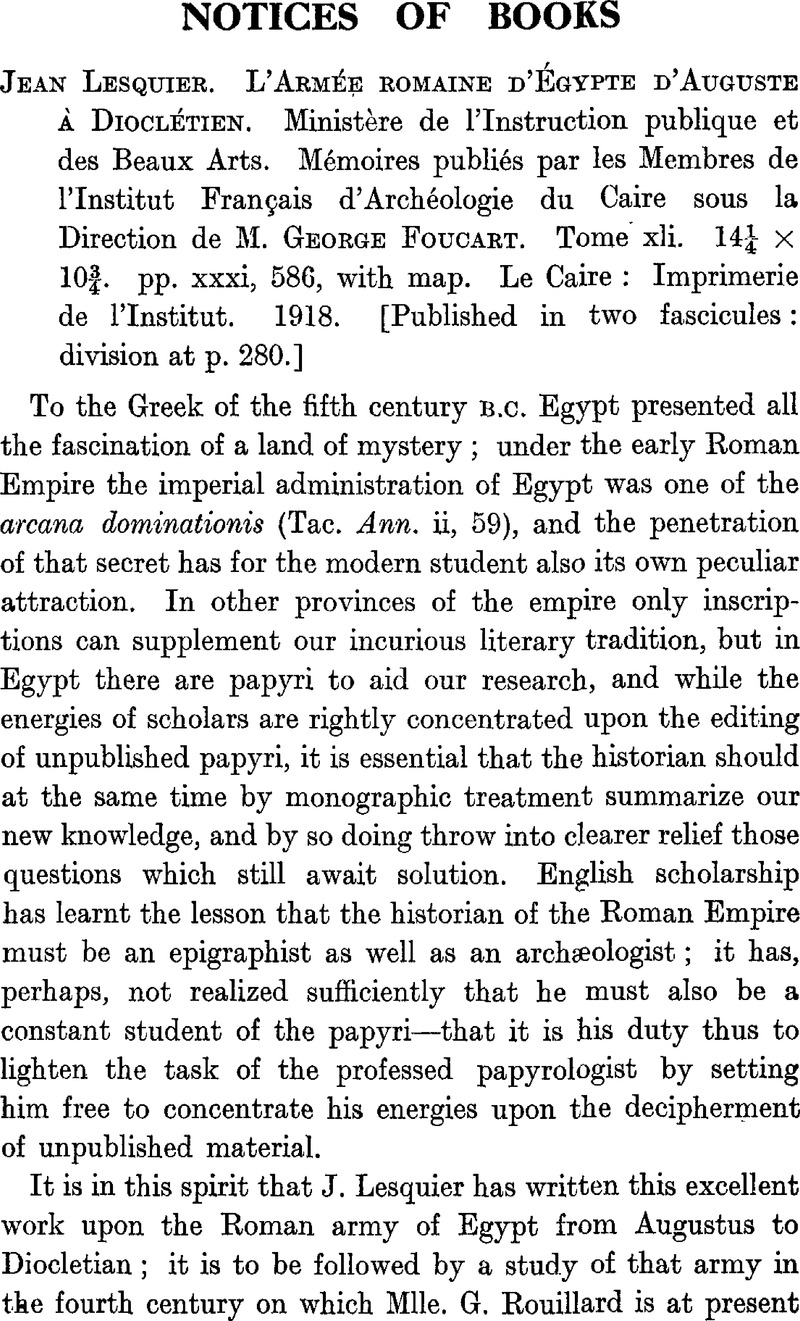No CrossRef data available.
Article contents
Jean Lesquier. L'Armée romaine d'Égypte d'Auguste à Dioclétien. Ministère de l'Instruction publique et des Beaux Arts. Mémoires publiés par les Membres de l'Institut Français d'Archéologie du Caire sous la Direction de M. George Foucart. Tome xli. 14¼ × 10¾. pp. xxxi, 586, with map. Le Caire : Imprimerie de l'Institut. 1918. [Published in two fascicules: division at p. 280.]
Review products
Published online by Cambridge University Press: 15 March 2011
Abstract

- Type
- Notices of Books
- Information
- Copyright
- Copyright © The Royal Asiatic Society 1920
References
page 356 note 1 Jean Maspero, Organisation militaire de l'Égypt byzantine. Paris, Champion, 1912 (= Bibliothèque de l'École des Hautes Études, Sciences hiatoriques ef philologiques, fasc. 201). pp. 159.
page 356 note 2 Oldfather, W. A. & Canter, H. V., The Defeat of Varus and the German Frontier Policy of Augustus, pp. 118. University of Illinois Studies in the Social Sciences, vol. iv, No. 2, 06, 1915. University of Illinois, Urbana.Google Scholar
page 357 note 1 “Il est possible que la préparation de la campagne éthiopienne ait été poussée plus loin qu'on ne l'estime généralement ” (Lesquier, p. 20). For our literary evidence, cf. Henderson, Bernard W., The Life and Principate of the Emperor Nero, 1905, pp. 223–224, 479–80.Google Scholar
page 358 note 1 The reader might have been referred to Von Premerstein's study of military conditions under Marcus Aurelius published in Klio, xii, 1912.Google Scholar
page 359 note 1 Cf. Platnauer, M., The Life and Reign of the Emperor Lucius Septimius Severus, Oxford, 1918, pp. 79, 122.Google Scholar
page 359 note 2 My friend H. I. Bell has pointed out to me that the supposed Ἰουδαïκς τραχος of a.d. 136–7 (cf. Lesquier, pp. 26, 67) is due to a misreading of the papyrus (Berlin Papyrus, 899, edited by Schubart in B.G.U. iii) : the reference is to the revolt of a.d. 116–17. Cf. Wileken, U., Zu den jüdischen Aufständen in Aegypten, Hermes, liv, 1919, pp. 111–12Google Scholar; in consequence “ jener jüdische Aufstand von 136/137 aus der Geschichte wieder zu streichen ist ”.
page 360 note 1 For the view previously held of a peculiarly military πκρισις, cf. the summary in Modica, M., Contributi Papirologici alla Ricostruzione dell' Ordinamento dell' Egitto sotto il Dominio Greco-Romano, Athenæum, Roma, 1916, pp. 254–255, a useful manual not mentioned in Lesquier's bibliography.Google Scholar
page 361 note 1 Here Lesquier would see the influence of the Egyptian military system of Ptolemaic times when in peace the soldiers lived as farmers on the land, and were allowed to marry : their sons, as under the later Roman system of the limitanei, inherited their lands on condition of themselves entering the army. “ Le légionnaire ne peut transmettre à son fils, servant comme lui, un κλρος tenu de l'Empereur : il n'en possède pas ; mais en le faisant entrer dans l'armée, il assure à ce bâtard le droit de cité romaine. Le recrutement en est facilité ; et il est probable que Rome a hétité des Lagides à la fois le mal d'une discipline relâchée et le remède qui l'a pallié ” (Lesquier, p. 211).
page 361 note 2 It is strange that Lesquier should discuss the recruitment of the auxilia in Egypt (pp. 216–26) without any reference to Cheesman's, G. L.The Auxilia of the Roman Imperial Army (Oxford, 1914)Google Scholar : Section II, Recruiting and Distribution, pp. 57–101 (for Egypt, cf. pp. 163–4, and for the Palmyrenes especially p. 88). Local recruitment for the auxilia in the first century was apparently general; cf. Cheesman, pp. 77–80.
page 362 note 1 In Geroke, & Norden's, Einleitung in die Altertumswissenschaft, Bd. iii2, pp. 281–295, Leipzig, 1914.Google Scholar
page 362 note 2 An outstanding example of such research is Rostovtsev's study of the origins of the colonate.
page 363 note 1 For new evidence on this subject cf. the ostraka published by White, Hugh G. Evelyn, “ Græco-Roman Ostraca from Dakka, Nubia ” : Class. Rev., xxxiii, 05–06, 1919, pp. 49–53.CrossRefGoogle Scholar
page 363 note 2 Herodian, 3. 8. 4. For a discussion of the passage cf. M. Platnauer, op. cit., pp. 167–9.


